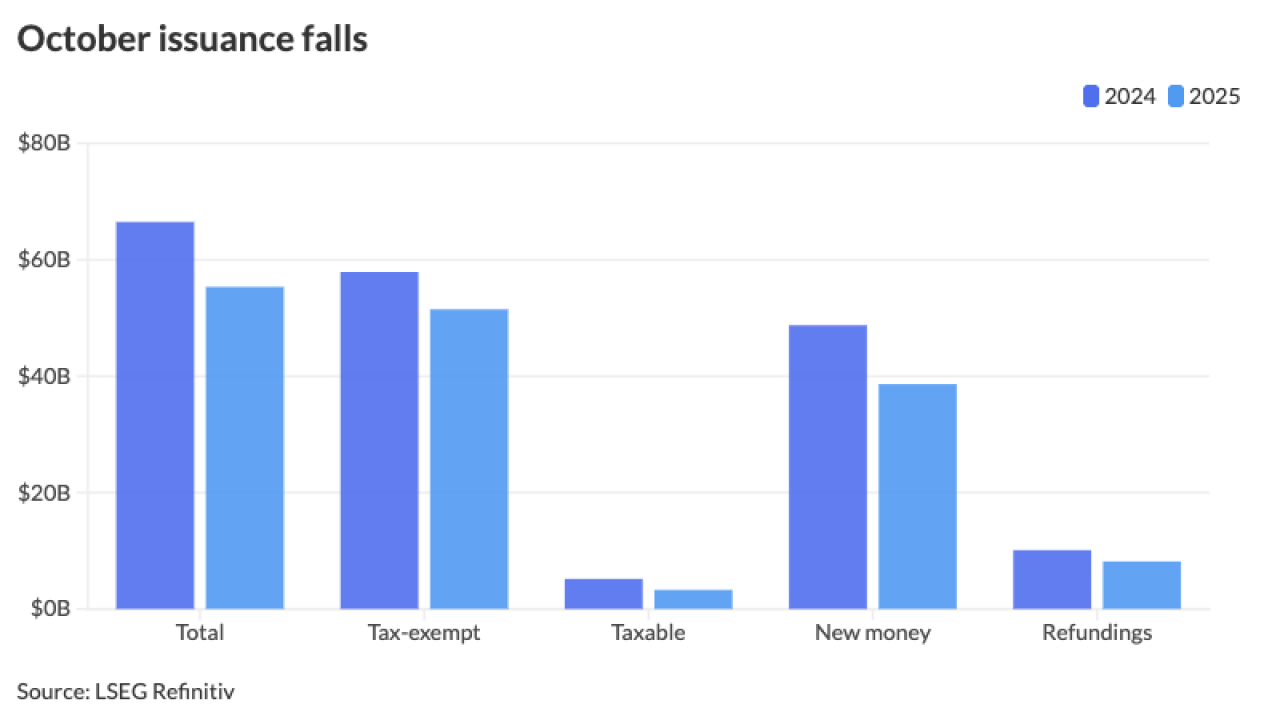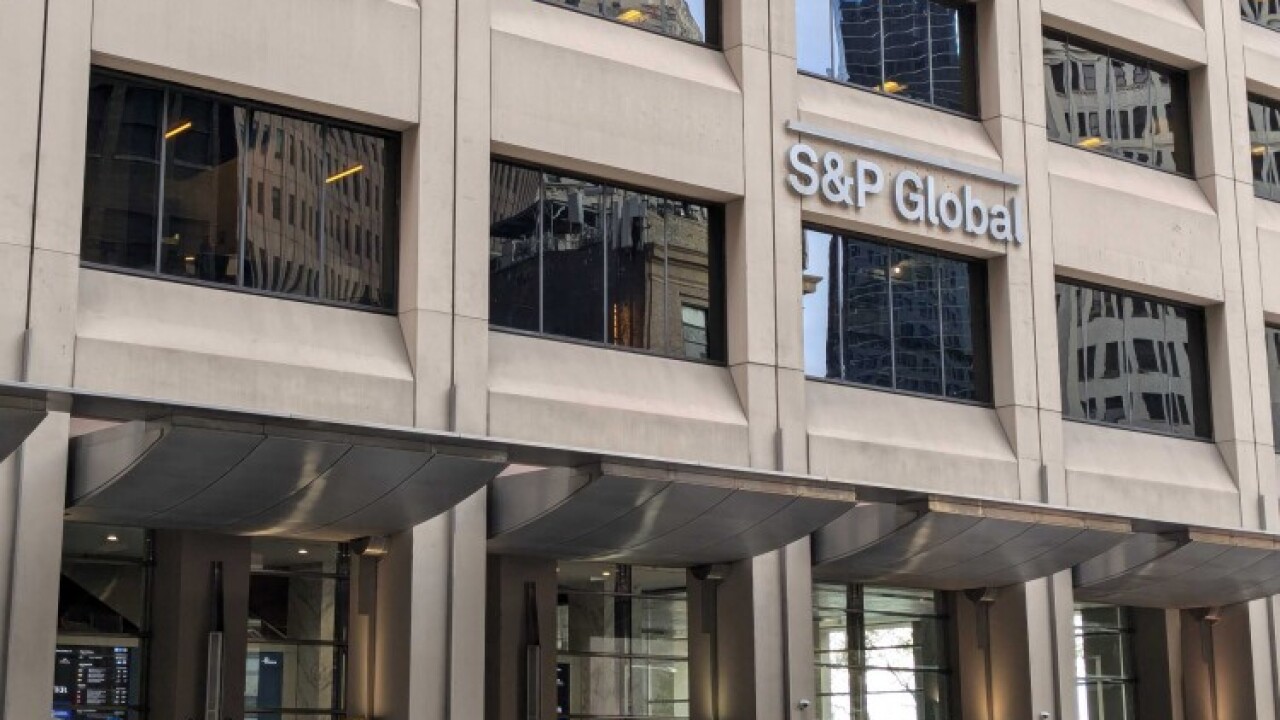
The Los Angeles Department of Water and Power is gearing up to price water revenue bonds, buoyed by a general market rally, an improved Fitch Ratings outlook, and spreads narrowing on its bonds.
RBC Capital Markets will lead a nine-bank syndicate to price $977.6 million in Series C water revenue bonds on Thursday, following a retail order period on Wednesday. PRAG is municipal advisor and Kutak Rock is bond counsel.
The bonds will pay for water system capital improvements, refund all or a portion of 2016 Series A and 2016 Series B bonds and pay issuance costs. DWP has applied for bond insurance, according to the online investor presentation, but the preliminary official statement doesn't outline which maturities could carry insurance.
Earlier this year, prospects were bleaker for the nation's largest municipal utility, which serves 739,000 active water service connections, reaching roughly 3.8 million residents, as well as 1.4 million electricity customers.
DWP received
"When the credit was first affected by the fires, spreads widened 50 or 60 to the benchmark," said Kim Olsan, senior fixed income portfolio manager at NewSquare Capital, but they are now 30 basis points tighter.
"When the fires first occurred, the question was, 'Where's the culpability or will it turn out to be something different from DWP procedures that caused the fires?'" Olsan said. "And will the credit drop from a double-A range to a single-A range?"
The water revenue bonds are pricing 50 to 70 basis points lower than they were in April when the
When the utility priced $1 billion in
"More recent issuances have experienced tighter spreads," said Mia Rose Wong, an LADWP spokeswoman. "We hope that this trend will continue, especially in light of Fitch's removal of the negative outlook."
Fitch Ratings on Oct. 23 revised its outlook for DWP power and water credits to stable from negative, and affirmed them both at AA-minus.
The rating agency said "the near-term likelihood of LADWP incurring a materially significant financial liability related to the Palisades wildfire has declined."
The bonds received a rating of Aa2 from Moody's Ratings ahead of the deal, maintaining the negative outlook assigned in January.
KBRA affirmed its AA rating and stable outlook ahead of the deal. It
A 29-year-old Florida man was arrested Oct. 8
Jonathan Rinderknecht, 29, of Melbourne, Florida, a former Pacific Palisades resident, was arrested in Florida on an arson charge, according to the U.S. Attorney's Office for the Central District of California. It's alleged that Rinderknecht started the fire on a hiking trail.
The fire Rinderknecht allegedly started on Jan. 1, named the Lachman Fire, was thought to be extinguished by firefighters, but it continued to smolder and sparked the Palisades wildfire on Jan. 7 when high wind conditions spread the blaze.
In its affidavit on the arrest, the Bureau of Alcohol, Tobacco, Firearms and Explosives "expressly ruled out power lines as a potential cause" for both the Lachman and Palisades fires, the investor presentation said.
That doesn't mean litigation threats are over for the DWP or the city.
Some uncertainty persists because of lawsuits that allege water and power operations contributed to the wildfire's progression and damage, including claims that DWP facilities caused secondary ignitions in the Palisades, Fitch said.
DWP also faces lawsuits alleging it failed to properly maintain its water system and reservoirs for the purpose of fighting fires, according to its investor presentation.
The city and the department "intend to vigorously defend against these lawsuits, and any others that may be filed," the presentation said.
If the DWP or the city are found liable, the damages could be material, Fitch said. There is also uncertainty as to "how any potential liability could be allocated between LADWP and the city," Fitch said.
Fitch said it revised the outlooks because DWP is unlikely to be affected over its 18-24 month outlook period, but added that not all credit risk has been eliminated.
The finding "carved down the near-term risk in the alleged ignition of the fire; which is why we took action," said Kathy Masterson, a Fitch senior director.
But there is still pending litigation that claims the power system could be responsible for secondary ignitions or the system could be responsible for prolonging the fire, Masterson said.
"There are outstanding lawsuits against both the water and power systems that aren't likely to be resolved within the outlook period and will continue to be a focus of Fitch's analysis," she said.
"The litigation is still in the early stages," said Audra Dickinson, a Fitch senior director. "There are over 2,000 cases. Inverse condemnation has been cited in the water cases, though there is a lot less precedence for that than for power utilities."
Fitch is basing how long it will take to resolve the litigation on power utility litigation, because there aren't historical water utility cases that are similar, Dickinson said.
Lawsuits related to wildfire claims in which power systems were blamed have taken multiple years to work their way through the courts, Masterson said. "I am not aware of any cases that cited secondary ignition sources," she said referencing claims that power lines could have furthered the length of time the fire burned.
"Most of the lawsuits do not contain a specific dollar amount, although one of the pending class action cases asserts a damages figure of greater than $10 billion," according to DWP's online investor presentation. "The cases are not yet at a stage where it is possible to reasonably estimate the potential ultimate financial exposure to the city of the Department."
DWP yields have come back quite a bit, said Jeff Timlin, a managing partner at Sage Advisory in Austin, Texas. When it priced $1 billion in power revenue bonds in April, they were plus-65 relative to the triple-A MMD, and since then yields have been halved to 35 above the benchmark, Timlin said.
"The market isn't assessing as much risk, but it hasn't compressed down to the original spreads," Timlin said.
"It's a very desirable credit, especially given high income taxes in California, but there is still a difference, because of the liability risk," he said.
"I think it's still evolving," Olsan said. "There is more of a positive bias, than a negative bias, but there is infrastructure to be rebuilt and users in the system who would come back on line once the infrastructure is restored and homes are rebuilt. That's probably a several-year process."
Sample spreads on the water side aren't as plentiful since DWP hasn't sold new money water revenue bonds since January 2024, but Olsan said a 5% coupon due in 2038 traded at 30-plus to BVAL, another in September in the same maturity traded for 33-plus to BVAL.





